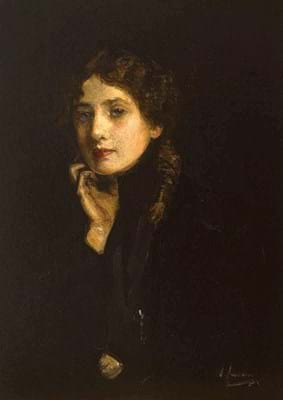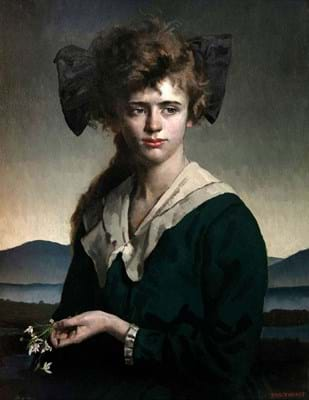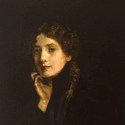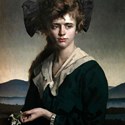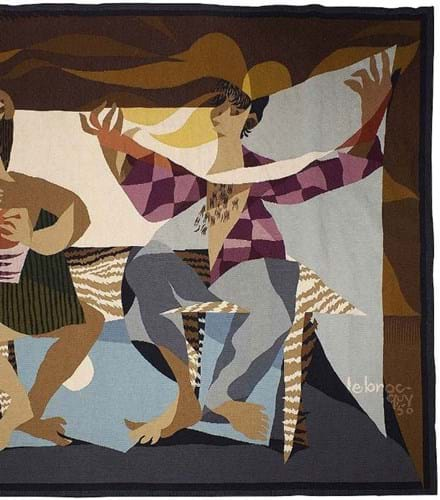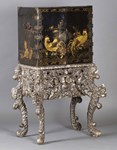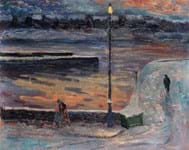A mix of Contemporary and period artworks by Irish and international artists generated decent bidding at the summer series of sales in Dublin.
The three auctions at Whyte’s, Adam’s (both 20% buyer’s premium) and de Veres (25% buyer’s premium) totalled a combined €2.43m (£2.15) from 485 lots, indicating the Irish art market continues its recovery since the financial crash over a decade ago – albeit at a sedate pace.
Like its Modern British equivalent, the top end of the 20th century Irish art market is the liveliest, with the largest sums paid out for the likes of Paul Henry, Walter Osborne, Jack B Yeats and Roderic O’Conor.
However, even here market sensitivity towards estimates and ‘seen’ material is a major factor and the latest sales contained a smattering of failures, including unsolds by Yeats and O’Conor.
Describing the bidding at Adam’s, managing director James O’Halloran said: “Like all sales these days, the high-quality works all did well, and the majority of buyers were Irish and living in Ireland.
“The next biggest cohort were UK-based buyers, and again mostly private.
“Beyond that we had bidding from Europe – where the Paul Henry is now going, but very little this time from US-based clients.”
Whyte’s
Dublin auction house Whyte’s was first up on May 27, offering 207 lots and posting a respectable €1.1m (£974,000) for 70% of the works offered. The sold rate was down slightly on March’s sale, which achieved a higher than average 90%, but the total was around the same.
As expected, the highest price went to a quintessential Paul Henry (1877-1958) landscape that sold on bottom estimate at €100,000 (£89,000). According to Whyte’s, Western Landscape (c.1935-40) displayed “all the hallmarks of the Belfast-born artist: a west of Ireland subject, thatched cottages, turf stacks, bog lake and dominant cumulous clouds”.
A mainstay of Irish art auctions, Henry’s works are among the safest in terms of investment, owing in part to the wide dissemination of his work in the form of tourist posters.
Sir John Lavery’s (1856-1941) small 14 x 10in (35 x 25cm) half-length portrait of his young model Mary Auras drew some of the strongest bidding of the day, making €75,000 (£66,400), comfortably over the lower €60,000 estimate. The price is an improvement on its last appearance at auction in May 2007 when it made £38,000 in an Irish Art sale at Christie’s London. Another small-scale portrait, also titled Mary in Black, sold in the same rooms four years later for £61,250 (with fees).
Lavery met the 16-year-old Mary in Berlin in 1901 and immediately embarked on a series of full-length portraits culminating in Printemps (1904), a painting of Mary carrying a spring blossom that caused a stir when it was acquired by the French government from the Paris Salon.
A contemporary label to the verso indicated Mary in Black had been selected for the St Louis Purchase Exhibition in 1904, a show that became something of a cause célèbre when it lost the financial backing and was cancelled at the last minute.
No Irish sale would be complete without the work of JB Yeats (1871- 1957) and A Quay Worker’s Home was the leading light here. It depicts a man standing in the dim interior of his modest home, an unusual subject for Yeats who normally presented the workers on the quayside or in the open air.
The mid-1920s oil on a small 9 x 14in (22 x 35cm) piece of slateboard belongs to an interim period when the artist’s style of oil painting was transforming from its early realism to its later more radical approach.
Formerly in the collection of Lord McAlpine, and with a label on the verso for the Waddington Galleries where McAlpine was a regular, it sold within estimate for €68,000 (£60,200).
Paintings by William Leech (1881- 1968), regarded as one of Ireland’s greatest Impressionists, are regaining popularity with Irish buyers. A typical still-life composition depicting flowers in a vase from a high viewpoint sold for a mid-estimate €60,000 (£53,000). It had last appeared on the market at Christie’s in May 2002 where it made £35,000.
Works exceeding expectations further down the price scale included a rare Surrealist painting by Nevill Johnson (1911-99). Nurses (1953) was knocked down at €21,000 (£18,600) against a €10,000-15,000 estimate.
Johnson was born in England but moved to Ireland, first to Belfast in the 1930s, then Dublin in 1946 to join Victor Waddington’s gallery.
Adam’s
Led by another Henry landscape – this one realising €115,000 (£101,000) – the smaller 156-lot sale held at fellow Dublin saleroom Adams netted €700,000 on June 12 with a sold rate of 75%.
Much of the pre-sale interest centred on a market-fresh portrait by Gerald Brockhurst (1890- 1978) showing a young woman, Florence Forsyth, holding a sprig of snowdrops against one of the artist’s stylised mountain backdrops.
The 23 x 18in (58 x 45cm) oil on panel was commissioned by the sitter’s father, an executive at Norwich Union in Dublin, and is thought to date from the late 1920s when she was training to be a dancer in London.
Two decades after this was painted, Brockhurst had become the most expensive portrait painter in Britain, charging 1000 guineas for an oil and limiting the number of commissions he would accept to 20 per year.
Consigned to sale by the sitter’s son, the portrait attracted six bidders and eventually sold above top estimate for €50,000 (£44,000) to a UK buyer. The price is some way off the $290,000 (£228,350) auction record fetched last autumn at Heritage Auctions in Texas for the striking portrait of the film star Merle Oberon. O’Halloran said: “I suspect that the Merle Oberon effect made all the difference for the Texas price, but our clients were very happy with their result.”
Other highlights in the sale included a landscape of the south of France by Mary Swanzy (1882- 1978), the Dublin-born artist who witnessed the birth of Modern art in Paris. Interest in her work has increased in recent years, helped by a major exhibition currently at the Crawford Art Gallery in Cork.
The landscape at Adam’s dated to c.1915, a year after she had exhibited for the first time in the Salon des Independents. Fresh to the market, it tipped over top estimate to sell for €32,000 (£28,300).
A late work of six Aran Island men in their traditional currachs by Seán Keating (1889-1977) last offered on the market in c.1989 sold towards its upper guide at €76,000 (£67,300). Post-dating 1965, Homeward Bound was created using Keating’s vast collection of photographs, sketches, drawings, and notes, and illustrates his artistic focus on the traditions of the people of Aran and the weather conditions.
De Veres
Louis le Brocquy (1916-2012) currently represents good value for money. One of the most celebrated Irish artists of the 20th century, he was also one of the big casualties of the 2008 crash.
Prices for his work are recovering, however, with his tapestry designs in particular doing well during this series. At the de Veres Irish Art & Sculpture on June 11 in Dublin, le Brocquy led the way, represented by three tapestries. Le Brocquy began to experiment with designs for weaving in 1948, working with the renowned tapestry-maker Tabard Frères et Soeurs in Aubusson, France.
Allegory (1950) – a series that has appeared around half a dozen times at auction – sold just over top estimate at €92,000 (£81,000). Signed and measuring 5ft 11 x 7ft 3in (80cm x 2.2m), Allegory, the artist’s third tapestry design, follows Travellers (1948) and Garlanded Goat (1949-50). Tapestries of Adam and Eve, listed with €30,000-50,000 guide prices, sold for €29,000 (£26,000) apiece.
Elsewhere at the Irish art sales, an Aubusson wool tapestry titled CúchulainnVIII (1999) by le Brocquy emerged at Adam’s where it improved on a €30,000-50,000 estimate to make €70,000. Signed and numbered 8/9, it had graced the walls of the five-star Shelbourne Hotel in Dublin for 25 years.
£1 = €1.13


